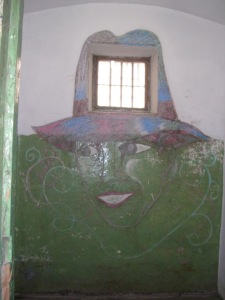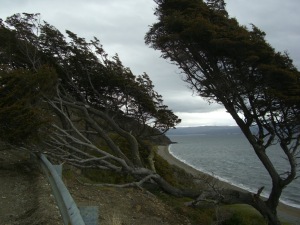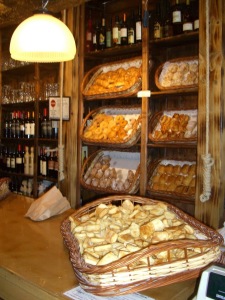Hold on. I’m here at the end of the world – down at the very point that says ciau to the rest of normal land – green and mountainous Argentina – where the coldest water, glaciers and ice begin and Chile is shoulder to shoulder at the end. The air is so pure and fresh you wonder if your lungs are the same. Breathe deep. Believe. The best cleansing one’s soul can have is listening to small waves lap the shores of Beagle Bay, named for an explorer, not a dog.

The end of the Andes and the world across Bengal Bay.
Sea gulls, comorants and all sorts of sea birds land and take off from shore lines. At Los Cauquenes Hotel, where I spent only last night, the spa offered chocolaterapia (chocolate body wrap) or a gold mask facial. I took the last because they had run out of chocolate supplies. The beauty specialists really painted a liquid mask of gold on my face. Most hotels have transformed into spas today but this one, with incredible views of the Andes covered in snow across the Beagle Bay, has impressed me with lights that go on as you walk down the halls, and go off when you pass.
In Ushuaia, (means – Bay that looks to the east) people live year round with rain, snow and sun over and over in a single day. Homes are constructed of wood or concrete and the chief industry is making televisions and domestic appliances. Lots of trout fishing, too, tourism, and a major influx of boats picking up stacks of containers filled with things for the rest of the world. I hired a taxi to take me to the town’s one Main Street to see sites (mostly tourist shops). The taximistro said that the pure indigenous Yamana still exist – Indio Indio, was his expression. But Ushuaia is very international: young girls wear red plaid Scottish kilts to school.
Ushuaia is surrounded by “cordilla navada” a range of the Andes where the snow ends halfway down the slopes across the board. It’s the first thing you notice and you ask is the snow line half way down the mountain or half way up the mountain. (The old half empty, half filled question. )  Because of constant wind in exposed areas, pine trees with peculiar bent form have evolved. They are called flag trees, resembling flags in a frightful wind. Right now, the bright red calafate trees (photo left) are in bloom. Later they produce rather acid berries that make good jam. There is also a line of moss called “Sphagnum mires” which came from ancient glacial pools that eventually retreated and left dead plants that didn’t decompose but kept the moss alive on its surface.
Because of constant wind in exposed areas, pine trees with peculiar bent form have evolved. They are called flag trees, resembling flags in a frightful wind. Right now, the bright red calafate trees (photo left) are in bloom. Later they produce rather acid berries that make good jam. There is also a line of moss called “Sphagnum mires” which came from ancient glacial pools that eventually retreated and left dead plants that didn’t decompose but kept the moss alive on its surface.
Because of the silence of the waters in the bays protected by the Andes string, sea lions and southern seals set up harems and raise their puppies on these rocks. Yes, it is amazing to step foot on this soil. Sea lions that aren’t involved in some sort of zoo flipper applaud?? After going to Sea World, I expect whales and dolphins to leap into the air and do back flips and then walk backwards on their tails. Alas. How warped we are.
Tierra del Fuego (the name in general of this tip end of South America. Cape Horn is further west.) has a lot in common with South Africa’s Cape of Good Hope. They both are located at the juncture of the two giant oceans,(Atlantic and Pacific) but here in Ushuaia it’s more about cold and ice and survival in the severest climate. In Cape Town, the climate is tropial enough to bathe in the bluest waters I’d ever seen and gardens of exotic flowers such as protea abound. Here, Beagle Bay, which spits ships out into the Drake Crossing, is constantly aflux with white topped waves and seaweed thickens at rocky edge shores. The bays and pueblos of Cape Horn are launch sites for those wishing to cross Drake’s Passage to work and play in Antartica or to just pass around the end of South America. Life in Ushuaia still doesn’t seem as severe as in shore communities of Greenland, where nothing is green and summer’s sun never sets nor winter’s moon. The North Pole has polar bears, the South Pole penguines and whales (killer and humpback among them) galore.
Typical home made breads at Ramas Generales (an old warehouse).
Imagine being Magellan, finding this little slip through to the next ocean. If he was not sea sick, I bet he drank a toddy to celebrate. I’m warned that the crossing to Antartica is the roug hest anywhere. Wear a dramamine patch. Charles Darwin, on an early expedition here, (h got seasick) was emotionally moved as he wrote about his experiences, and early on the South American Missionary Society set up a mission to bring the Gospel to the canoe people and the nomadic Yamana. A conflict developed between a maritime police group and the Anglican mission. Of course the mighty white man wanted to change the ways of the “poor little things” in typical colonialist fashion, because the Indians lived in shelters formed from branches, covered in tree leaves or sea lion leather, and they had lived virtually naked in a harsh frozen environment. These natives had survived for 6500 years. You think they’d know what they were doing.
hest anywhere. Wear a dramamine patch. Charles Darwin, on an early expedition here, (h got seasick) was emotionally moved as he wrote about his experiences, and early on the South American Missionary Society set up a mission to bring the Gospel to the canoe people and the nomadic Yamana. A conflict developed between a maritime police group and the Anglican mission. Of course the mighty white man wanted to change the ways of the “poor little things” in typical colonialist fashion, because the Indians lived in shelters formed from branches, covered in tree leaves or sea lion leather, and they had lived virtually naked in a harsh frozen environment. These natives had survived for 6500 years. You think they’d know what they were doing.
In the late 19th century, the first settlers arrived from Argentina and Croatia and turned Ushuaia into a prison colony in 1902 which at one point, legend has it, housed even the grea t tango singer Carlos Gardel. In the prison the occupants were trained through workshops to redesign their habits to be better citizen. It closed in 1947 and has become a museum alongside a newer museum called Museo del Fin del Mundo ( Museum at the End of the World – now is that depressing?) which I believe we will visit at the end of our 11 day sail to Antarctica.
t tango singer Carlos Gardel. In the prison the occupants were trained through workshops to redesign their habits to be better citizen. It closed in 1947 and has become a museum alongside a newer museum called Museo del Fin del Mundo ( Museum at the End of the World – now is that depressing?) which I believe we will visit at the end of our 11 day sail to Antarctica.
Photo: Cell painted with face of Gardel
Ushuaia Prison Museum


